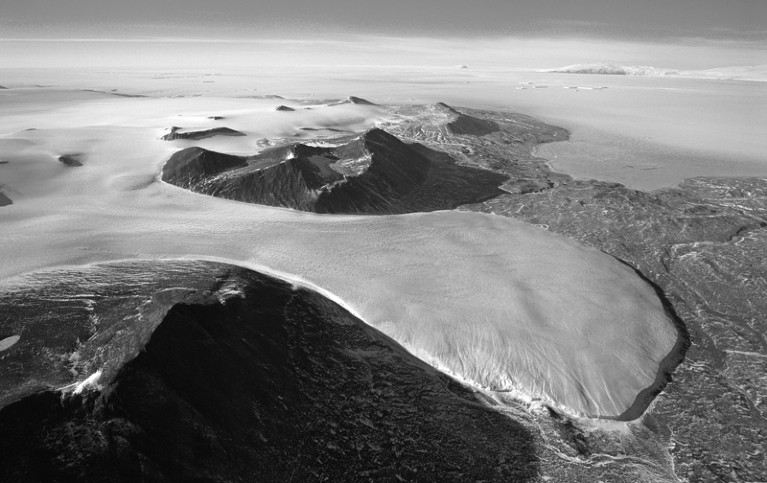
It’s 50 years since scientists first suggested that the West Antarctic Ice Sheet could melt away.Credit: Yann Arthus-Bertrand/Getty
Fifty years ago, many scientists were looking up. In 1968, the Russians sent the first animals to orbit the Moon (including a couple of tortoises), and NASA’s Apollo programme kicked into gear to produce the first views of Earth from space. But in Antarctica, John Mercer was looking down — and he was concerned about what he saw.
That year, the late Mercer, a glaciologist at Ohio State University in Columbus, first warned about the potential for rapid sea-level rise from melting ice caps. His landmark paper drew on fieldwork at the Reedy Glacier, which feeds into West Antarctica’s Ross Sea (J. H. Mercer Int. Assoc. Sci. Hydrol. Symp. 79, 217–225; 1968). Geological evidence from a former lake, located at an altitude of 1,400 metres in the Transantarctic Mountains, suggested that the area was once awash with open water and floating icebergs. Mercer took that as evidence that the entire West Antarctic Ice Sheet had once melted away.
The paper was an intriguing synthesis of the science of the times. Using multiple lines of evidence, Mercer sought to explain how sea levels could have risen by 6 metres in the previous interglacial period, around 120,000 years ago. The melting of Greenland or the East Antarctic Ice Sheet could not explain it, because both are located on solid earth and would respond relatively slowly to warming. By contrast, much of the West Antarctic Ice Sheet is grounded well below sea level. That makes it a “uniquely vulnerable and unstable body of ice”, Mercer wrote.
Many credit a 1974 paper by Johannes Weertman, a geophysicist at Northwestern University in Evanston, Illinois, with providing a technical explanation for how such a massive ice sheet could disintegrate (J. Weertman J. Glaciol. 13, 3–11; 1974). And the late Bob Thomas, a NASA glaciologist, spent years investigating and explaining how floating ice shelves acted as corks, stemming the flow of land-bound glaciers into the sea. But Mercer still deserves credit for sounding the alarm.
It took a while for the idea to take hold. Advanced numerical ice-sheet models developed in the late 1980s tended to downplay the risk of rapid ice loss from western Antarctica, and the Intergovernmental Panel on Climate Change suggested in its 1995 report that Antarctica as a whole was stable. But evidence to the contrary mounted: the massive Larsen A and B ice shelves collapsed in 1995 and 2002, respectively, followed by a major rift in Larsen C in 2017. In 2014, a team of scientists declared that the loss of ice in the Amundsen Sea Embayment had accelerated and appeared “unstoppable”.
The future of the ice sheet, which holds enough water to boost global sea levels by more than three metres, is now at the top of the Antarctic research agenda. Scientists are still scouring the world for palaeoclimate records to pin down past sea-level change, modellers are refining their calculations and fieldwork continues apace. As early as next month, the US National Science Foundation and the UK National Environmental Research Council are expected to jointly announce the recipients of a US$25-million fund for research on the future of the Thwaites glacier, which flows into the Amundsen Sea. Satellite measurements indicate that melting there has doubled in the past several years, and now accounts for roughly 10% of the global sea-level rise.
In a 1978 paper in Nature, Mercer updated his arguments in clear and elegant terms. “A disquieting thought is that if the present highly simplified climatic models are even approximately correct,” he wrote, “this deglaciation may be part of the price that must be paid in order to buy enough time for industrial civilisation to make the changeover from fossil fuels to other sources of energy” (J. H. Mercer Nature 271, 321–325; 1978).
That thought still rings frighteningly true. Thus far, the 2015 Paris climate agreement, which commits the world to limiting warming to 1.5–2 °C, remains intact, despite the objections of US President Donald Trump. But grand commitments aside, the governments of the world, and by extension the citizens that they represent, have yet to demonstrate that they are up to the task of reducing greenhouse-gas emissions quickly enough to avert the most disastrous consequences.
Fifty years is the blink of an eye in geological terms, but it is long enough for science to raise its voice. It might feel like pushing against the tide, but researchers have to keep making the point that strong action on emissions could still prevent the worst. Without it, significant sea-level rise will become a certainty. In the long run, higher oceans could well become one of humanity’s most obvious self-inflicted wounds.







